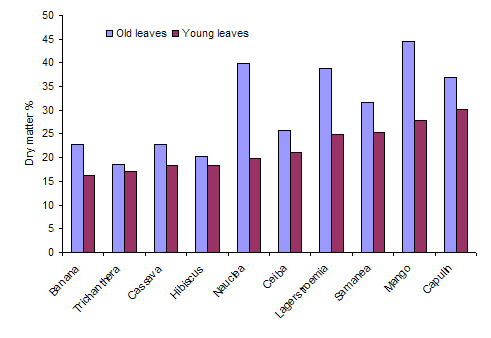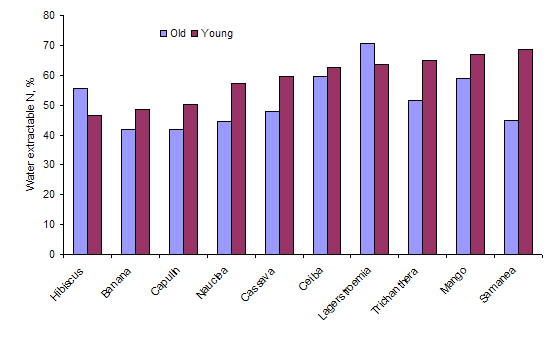Effect of age of
leaves from forage trees on nutritive value
Ngo Thuy Bao Tran
An Giang University, Vietnam
ntbtrancnty@yahoo.com
ntbtrancnty@yahoo.com
Abstract
The objective of this experiment was to obtain information on the relative nutritive value of young versus old leaves taken from trees considered to be suitable for feeding to livestock. Measurements were made of dry matter, nitrogen and the water extractability of DM (WEDM) and N (WEN) in ten trees: Banana, Cassava, Hibiscus rosa-sinuensi, Trichanthera gigantea, Ceiba, Samanea saman, Nauclea, Mango, Largesroemia, and Muntingia calabura.
All the above indices of nutritive value were better for young than for old leaves.
The higher content of N and of WEDM and WEN in young versus old leaves in a wide range of trees indicates that live stock should have better performance traits when they are fed young rather than old leaves. The water-extractable N may be indicative of the relative suitability of the leaves as feeds for monogastric animals (high WEN) and ruminants (low WEN).
Key words: Banana, Cassava, Hibiscus rosa-sinuensi, Trichanthera
gigantea, Ceiba, Samanea saman, Nauclea,
Mango, Largesroemia, Muntingia calabura, nutrition, water extract
Introduction
Live stock play an important role in the farming system as they provide meat and milk for humans, income for farmers and manure for cropping. Nowadays, the rapid increase in population together with the economic development in Vietnam has led to an increase in demand for food generally, and animal protein in particular. So development of live stock production systems is one of the Government strategies. The traditional feeding system for livestock is based on locally available feed resources such as rice straw, rice bran, sugar cane tops, sweet potato vine, cassava root meal and agro-industrial by-products with the use of commercial feed as a supplement. Green plants are used as traditional feeds in diets for animal in Mekong delta, but very little is known about their nutritive value and especially protein availability.
Farmer in the Mekong delta that grow Trichanthera gigantea select the young leaves rather than the old ones for feeding to their animals (Nguyen Thi Hong Nhan, personal communication). Their belief that the "new" leaves on the Trichanthera gigantea tree have higher nutritive value than older leaves is supported by research in Cambodia (Chhayty et al 2003), in which cassava leaves from young re-growths (about 2 months old) had higher digestibility for pigs than leaves from plants grown for root production and which were 5 months old when the leaves were harvested.
The main aim of the present experiment was to study the nutritive value of young and old leaves from a range of trees found in the Mekong delta.
Materials and methods
Study sites
The leaves were collected from trees located around Long Xuyen
and Can Tho city. The experiment was carried out in the laboratory
of the Faculty of Agriculture and Natural Resources of An Giang
University, in Long Xuyen City, Vietnam.
Sample collection
Samples were taken of leaves from the top and from the bottom of
the following trees: Cassava, Hibiscus
rosa-sinuensi, Banana, Trichanthera gigantea, Ceiba, Samanea
saman, Nauclea, Mango, Largesroemia and Muntingia
calabura. It was assumed that the leaves at the top of the
trees or shrubs are the young leaves and that the leaves at the
bottoms are the old leaves. Plant samples were collected in the
morning and immediately put into plastic bags to avoid moisture losses
and brought to the laboratory in the same day.
Chemical: analysis
Duplicate samples were analysed for dry matter (DM), crude protein (CP) and
water-extractable DM and N. The dry matter content was determined by drying to constant
weight in a forced draught oven. Nitrogen was measured by the
Kjeldahl technique according to the AOAC (1990) procedure. The water extractable
DM and N were determined by the methods described by Ly and Preston
(2001).
Statistic analysis
The data were subjected to analysis of variance (ANOVA) using the General Linear Model of the Minitab software (version 13.3). Sources of variation were: trees, position in tree and error.
Results and discussion
Young leaves had lower content of DM and higher concentrations of N and water-extractable DM and N, than old leaves (Table 1 and Figures 1, 2, 3 and 4). The differences in favour of young leaves were consistent for all the trees, with two exceptions (Hibiscus and Lagerstroemia) in the case of the water-extractable N; however, the magnitude of the difference varied among the trees.
|
Table 1: Mean values for DM, N and water extractable DM (WEDM) and N (WEM) in ypung and old leaves from a range of trees |
||||||||
|
|
DM, % |
WEDM |
% N in DM |
WEN |
||||
|
|
Young |
Old |
Young |
Old |
Young |
Old |
Young |
Old |
|
Mango |
27.8 |
44.4 |
61.8 |
53.8 |
3.02 |
1.28 |
66.7 |
59.2 |
|
Banana |
16.3 |
22.8 |
44.3 |
31.6 |
3.03 |
2.16 |
49.8 |
41.9 |
|
Nauclea |
19.8 |
39.8 |
35.7 |
19.3 |
3.60 |
2.39 |
56.8 |
44.3 |
|
Capulin |
30.1 |
36.8 |
27.7 |
17.8 |
3.86 |
2.73 |
49.8 |
42.3 |
|
Hibiscus |
18.4 |
20.3 |
38.4 |
31.9 |
4.23 |
3.99 |
46.6 |
55.6 |
|
Ceiba |
21.2 |
25.7 |
42.8 |
34.6 |
4.25 |
2.75 |
62.7 |
59.5 |
|
Trichanthera |
17.1 |
18.5 |
44.9 |
36.0 |
4.32 |
2.48 |
64.8 |
52 |
|
Lagerstroemia |
24.9 |
38.8 |
43.4 |
38.5 |
4.45 |
2.90 |
66.6 |
70.6 |
|
Cassava |
18.3 |
22.9 |
48.9 |
41.3 |
4.88 |
3.30 |
59.4 |
47.9 |
|
Samanea |
25.4 |
31.6 |
48.0 |
28.9 |
6.10 |
3.49 |
68.7 |
45.8 |
|
Mean values |
21.9 |
30.2 |
43.7 |
33.2 |
4.13 |
2.83 |
58.9 |
51.7 |
|
SEM/Prob. |
0.10/0.001 |
0.22/0.001 |
0.038/0.001 |
0.77/0.001 |
||||

Figure 1: Dry matter content
of young and old leaves in a range of trees

Figure 2:
Water extractable DM in young and old leaves in a range of
trees

Figure 3: Nitrogen content in young and old
leaves from a range of trees

Figure 4: Water-extractable N in young and old leaves from a range of trees
The results of this experiment indicate that young leaves will be better sources of digestible nutrients than old leaves taken from the same tree. These findings support the observations of Nguyen Thi Hong Nhan (personal communication) concerning farmer practices on use of Trichanthera foliage in the Mekong delta (the farmers select the young leaves for feeding to their live stock) and of Chhayty et al (2003) in Cambodia where young leaves from cassava regrowth were more digestible for pigs than old leaves taken at the time of root harvest.
As
plant tissue matures the proportion of cell wall increases while cell
content is reduced and, within both the cell wall and cell content,
there are changes in chemical composition (Oboe 1980). The stage of
growth at the time of cutting is the most important crop factor
determining the nutritive value of the conserved product. The later
the date of cutting the larger will be the yield, the lower the
digestibility and the lower the voluntary intake of dry matter by animals
(McDonald et al 1995)
The fact that the water-extractable DM and N were lower in the young compared to old leaves of cassava, is in accordance with the report by Ravindran and Ravindran (1988) that with maturity, the fibrous fraction of cassava leaves changes it structure and composition. The superior nutritive value of young rather than old cassava leaves could be due to the effect of possible changes in the linkage of nutrients to the fibre fractions. In this respect, it may be that high values for water-extractable N is indicative of the suitability of such leaves / plant species as feeds for monogastric animals while low values could imply they should be fed to ruminants.
Conclusion
- The higher content of N and of water-extractable DM and N in young versus old leaves in a wide range of trees indicates that live stock will have better performance traits when they are fed young rather than old leaves.
- The water-extractable N may be indicative of the relative suitability of the leaves as feeds for monogastric animals (high WEN) and ruminants (low WEN).
- Research is needed to establish the relevance of these relationships in a
practical feeding situation.
Acknowledgements
The financial support for this study was provided by the MEKARN programme of sida-SAREC. The author would like to thank the Agriculture and Natural Resources Department of An Giang University, Long Xuyen City, Vietnam for making available the facilities for this study. The author also would like to thank Dr Preston and colleagues for advice and guidance.
References
AOAC 1990
Official methods of analysis. Association of Official Analytical Chemists,
Arlington, Virginia, 15th
edition, 1298 pp.
Chhay Ty,
Preston
T R and Ly J
2003: The
use of ensiled cassava leaves in diets for growing pigs. 2. The
influence of type of palm oil and cassava leaf maturity on digestibility and N
balance for growing pigs.
Ly J
and Preston T R 2001
In vitro estimates of nitrogen digestibility for pigs and water-soluble
nitrogen are correlated in
tropical forage feeds.
Oboe 1980
McDonald Animal nutrition, fifth Edition
Ravindran V and Ravindran G 1988 Changes in the nutritional composition of cassava (Manihot esculenta Crantz) leaves during maturity. Food Chemistry (27): 299-309